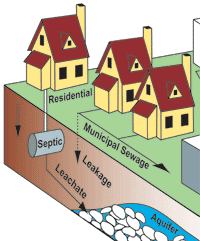
Photo from wikipedia
The extent to which chemicals bioaccumulate in aquatic and terrestrial organisms represents a fundamental consideration for chemicals management efforts intended to protect public health and the environment from pollution and… Click to show full abstract
The extent to which chemicals bioaccumulate in aquatic and terrestrial organisms represents a fundamental consideration for chemicals management efforts intended to protect public health and the environment from pollution and waste. Many chemicals, including most pharmaceuticals and personal care products (PPCPs), are ionizable across environmentally relevant pH gradients, which can affect their fate in aquatic and terrestrial systems. Existing mathematical models describe the accumulation of neutral organic chemicals and weak acids and bases in both fish and plants. Further model development is hampered, however, by a lack of mechanistic insights for PPCPs that are predominantly or permanently ionized. Targeted experiments across environmentally realistic conditions are needed to address the following questions: (1) What are the partitioning and sorption behaviors of strongly ionizing chemicals among species? (2) How does membrane permeability of ions influence bioaccumulation of PPCPs? (3) To what extent are salts and associated complexes with PPCPs influencing bioaccumulation? (4) How do biotransformation and other elimination processes vary within and among species? (5) Are bioaccumulation modelling efforts currently focussed on chemicals and species with key data gaps and risk profiles? Answering these questions promises to address key sources of uncertainty for bioaccumulation modeling of ionizable PPCPs and related contaminants. This article is protected by copyright. All rights reserved. © 2022 SETAC.
Journal Title: Environmental toxicology and chemistry
Year Published: 2022
Link to full text (if available)
Share on Social Media: Sign Up to like & get
recommendations!